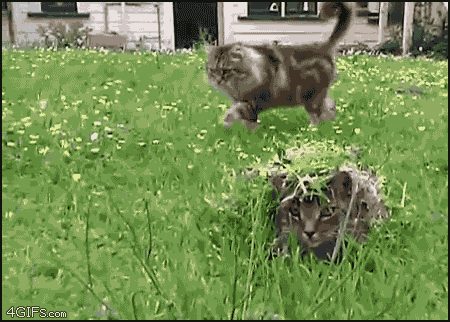|
|
Post by C R E E K on Aug 18, 2014 12:58:20 GMT -5

Tail Signals
Tail Held Erect Stop
Tail Rippling Move Forward Slowly - With Care
Tail Held Erect and Sweeping Slowly from Side to Side Retreat Silently
Tail Pointing Low, Parallel to the Ground and Sweeping Spread Out
Tail Flattened Get Down
Tail Bobbing Enemy Sighted
Tail Hooked Danger
Tail Pointed Sharply Go That Way
Tail Held Erect and Waving from Side to Side Stay Behind Me
Tail Kinked over Back Follow Me
Tail Flicking over Back Leave, But Be Careful
Tail Tip Facing Other Way Attack
Tail Flicks
A tail flick can be used in many ways. It can mean, "Follow me," "I heard you," or even, "Be quiet!" Listed below are some different situations:
◾A sharp flick and an agitated expression usually means the cat is annoyed, irritated, or impatient
◾A bristle and a sharp flick of your tail usually means "Get over here now! I'm angry with you!"
◾A flick and jerking your head in a certain direction means "Meet me to the bushes at your left" or "Sneak out of camp with me through the brambles to the right."
◾If you call out to someone and their back is to you, they can flick their tail to show that they've heard.
◾Sticking your tail straight up in the air and flicking it sharply down means "Sit!"
◾An eye-roll and a flick of the tail means "Whatever."
◾A mrrow of laughter and a flick of a tail means "That was a good joke."
◾Saying, "Oh, fox-dung, I gotta go!" and flicking your tail means "Sorry! Talk to you later?" or "Yikes! I've gotta go use the dirtplace!"
◾Flicking your tail at a she-cat's belly and smiling means "She's expecting kits!"
◾Flicking your tail at someone and making a face means "What is wrong with him/her?"
◾A sharp flick of your tail during battle can mean two things; it can mean "Attack!" or "Help me!"
◾A shrug followed by a tail flick: "Oh well."
◾Putting a tail over another cat's mouth means "Shut up, mouse-brain!" when the flick/movement is sharp or "Please, quiet" when the cat is talking too much.
◾A flick in a certain direction can emphasize that they've got to go or look there.
◾A normal flick can just be caused in amusement.
◾A tail flick can be a way to vent anger or rage.
◾Sometimes a cat can flick their tail when about to say something funny or sarcastic.
◾A tail flick can also be executed in an arrogant, conceited, or contemptuous manner.
◾Anxiety is another feeling that can trigger stiff tail flicks.
◾Though many tail flicks occur in rash emotions, the tail can also be flicked happily.
◾ A tail flick can mean that the cat is bored.
◾The tail can be flicked playfully on another cat's muzzle.
◾A flick executed in the air can change the direction the cat will land.
◾The need to protect can also be demonstrated by a tail flick.
◾A cat may flick his/her tail to prompt something.
◾The tail can be flicked in a proud manner.
◾A cat may also flick their tail when about to give them a lecture on what is right.
◾Eagerness can cause tail flicks as well.
◾A tail flicking one way, then the other is used when one is to surround a cat with others.
Other
There are several other motions that can be done with the tail. Listed below are some different situations:
◾Stroking another cat's spine or shoulder with the tail is a sign of affection or sympathy. Stroking on the cheek has the same meaning.
◾Lashing their own tail usually happens in times of anger. However, this can also be a sign of excitement.
◾Wrapping their tail around another cat shows affection or the need to protect. Mother cats often wrap their tail around their kit(s). The tail can also be used to beckon another cat.
◾The tail can also show different emotions; a drooped tail, for instance, usually means the cat is sad.
◾When first starting to hunt, it is instinct to swish their tail, but in order to catch prey properly, the tail must be kept still.
◾Swishing their tail can mean that the cat is very excited and ecstatic. It can also be a sign of commencing an action or contemplating an important decision.
◾Lifting their tail up is a form of composure, just as we humans sit up to recompose ourselves.
◾The tail can be used to brush another cat away if they're not wanted. However, it can also be used for the opposite: to beckon a cat closer.
◾When a cat cares for another cat, he/she can smooth their fur with the brush of the tail.
◾A cat can whisk their tail when being conceited to show that they know everything.
◾Twitching their tail can be a sign that they are skeptical about something.
◾Crossly whipping their tail is a demonstration of anger.
|
|







